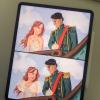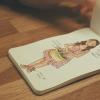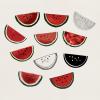Improve Your Style
As the saying goes? Nothing comes from nothing and practice makes perfect.
As the saying goes? Nothing comes from nothing and practice makes perfect.
You never stop learning as an artist. And that's why it's still essential for me to take the time to practise, regardless of whether I'm working on a commission or not. Sometimes it's much more theoretical and involves a more in-depth examination of anatomy, sometimes it's a bit more fun and relaxed. Depending on which skill I'm focussing on.
OOTD Sketchbook
Between the learning sessions, simply as a break in between, I also liked to draw in a sketchbook. I kept an OOTD - Outfit Of the day sketchbook. I drew lots of outfits and mini-mes in it. It's a good opportunity for me to practise, stay in practice, try out new things and also draw more freely than when I'm working on commissioned pieces where I'm given a brief of what to illustrate.
Best Procreate Brush
I'm often asked what my favorite brush for Procreate is, the one that allows you to create the best images or write the most beautiful hand lettering. Unfortunately, I can't give you a simple answer to these questions. Digital drawing is more of a medium than a style. You can explore just as many artistic styles digitally as you can with traditional methods. The best brushes, colors, and textures to use depend on the style you're aiming for.
Finding your favorite brushes is an integral part of developing your own artistic style. What I would recommend is to simply experiment. For creating an aesthetic image, it's generally easier not to mix too many brushes and styles.
Paper and Sketchbook
When drawing on paper, it can make a huge difference whether you use a suitable paper or not. There are a few very simple tips:
For watercolours, it is best to use slightly thicker paper. Whether it's more like 120 g/m2 or 200g/m2 or even firmer is based on personal preference. There are rougher and smoother papers. I sometimes use one or the other.
For handlettering projects with brush pens and felt pens, I would choose a rather smooth-coated paper because the felt tips break more quickly when you write with them on rough paper. The paper should not be too fibrous so that the felt tip pen does not run.
I usually use paper from Hahnemühle or Canson. My sketchbooks are mainly from Moleskine.
Sketchbooks are a great way to keep drawings already bound. You don't have to file sheets. It can be especially helpful when you're going through a creativity block and you can look through old sketchbooks to see how you've developed and realise that maybe you're not as bad as you think you are.
I hope this has helped you a little.
Be inspired and blessed!
Specific Drawing Skills
If you are very ambitious to improve your drawing skills from scratch, it is worth analyzing the general ability to draw a little more closely and dividing it into different skills. This makes it possible to analyze and identify any weaknesses. And it also allows to work specifically on one or more skills.
I would differentiate into the following sub-skills:
- Theory of colours
- Composition
- Proportions
- Handling medium
- Perspective
- Shadow/Light


